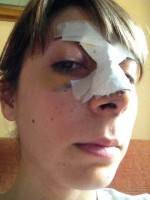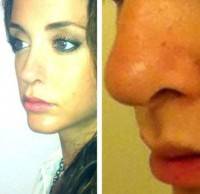Rhinoplasty to remove hump
The nose is a complete structure that must be addressed as a unit and not in parts or sections. From your photos I can see the dorsal hump and the wide amorphous tip.
However without seeing your complete profile ( chin projection, chin bones, and brow/ forehead) I can not determine if there is over projection of the nose or not.
A complete exam and evaluation is required. That being said I would not recommend a tip-plasty alone, but a full structural rhinoplasty.
Please consult with an experienced rhinoplasty expert. (James Shire, MD, Chattanooga Facial Plastic Surgeon)
A tip rhinoplasty would probably not work for you. You need rasping of the hump, tip work to narrow it, but also rotation of the tip and shortening of the nose as well.
A full rhinoplasty is what you will need to address all your concerns and expectations. Seek an experienced rhinoplasty plastic surgeon to do so. (Elias G. Gikas, MD, Chicago Plastic Surgeon)
I cannot say for sure without a full exam, it does appear you would be a good rhinoplasty candidate. A tip rhinoplasty will only address the lower 1/3 of the nose. If you would like to address issues such as a dorsal hump and overprojection, I would recommend considering a complete rhinoplasty instead. (Mark Hamilton, MD, Indianapolis Facial Plastic Surgeon)
It appears that your nose has a dorsal hump, and a bulbous tip. The tip of the nose is formed by two symmetrical pieces of cartilage.
These are called the lower lateral cartilages. A tip rhinoplasty would involve using suture techniques to bring the two cartilages closer together. A conservative amount of cartilage may also be removed.
This would have the effect of making the tip smaller and more well-defined.The tip rhinoplasty alone would not address the hump on the dorsum of the nose. You mentioned that the hump is visible when you look in the mirror and “sticks out.” In order to address the hump a full rhinoplasty would be required. This would involve using instruments to shave down the hump.
Once the hump and tip are in balance the last part of the procedure would involve osteotomies to reposition the nasal bones. This is required almost any time a hump is taken down, and has the effect of narrowing the upper portion of the nose.With a close-up photo it’s difficult to tell how far your nose projects. However, your surgeon could also deep project the nose at the time of surgery.Osteotomies involve wearing a splint on the nose for 5 to 7 days. Bruising typically lasts about two weeks. (Austin Hayes, MD, Portland Plastic Surgeon)
This is the most common surgery that I perform. Tip of nose surgery requires a plastic surgeon with a lot of experience. I would use closed rhinoplasty to reduce your tip cartilages. I may also narrow the alar base to give you the best result. (Rajan Uppal, MBBS, FRCS, London Plastic Surgeon)
Over-projected bulbous nose with hump
I agree with your assessment of your nose with respect to both the tip width and the dorsal hump. A well done rhinoplasty will refine your tip, lower the over-projection, and remove the hump. The end result should be a balanced and natural look that does not look “done”.
In your case this is best achieved as an open septo-rhinoplasty to address all of the above components appropriately at once. Make sure to choose a board certified plastic surgeon with ample experience in rhinoplasty. (S. Daniel Golshani, MD, FACS, Beverly Hills Plastic Surgeon)
Over projected-masculine nose with hump
In order to properly ‘feminize’ your nose and slim its proportions you will need a full rhinoplasty. Be prepared to wait 6-8 months for a final result. You will notice a significant improvement right away, but lingering swelling and ‘woody’ feeling of your nose will remain with you for months. (Gary M. Horndeski, MD, Texas Plastic Surgeon)
The tip can be refined. When the tip is deprojected, the bridge will have to be altered as well to improve nasal balance. (Kenneth B. Hughes, MD, Los Angeles Plastic Surgeon)


